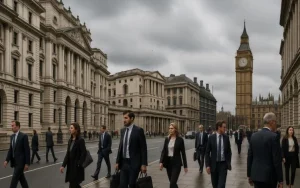How Much Does Tax Avoidance Cost the UK Each Year? | Facts & Analysis

Tax avoidance, while legal, costs the UK government billions each year in lost revenue that could support vital public services.
As HMRC strengthens its compliance efforts, understanding the scale and impact of tax avoidance becomes increasingly important. In the 2023 to 2024 tax year alone, avoidance contributed significantly to the overall tax gap.
This blog explores how much tax avoidance costs the UK annually, who is responsible, and what measures are being taken to tackle it.
What is Tax Avoidance?
Tax avoidance refers to the use of legal methods by individuals, corporations, or other entities to minimise their tax liability. While it doesn’t break the law, it often involves bending rules in ways that Parliament never intended.
It is a widespread practice that includes using legal tax reliefs, structuring income to exploit tax exemptions, or making use of offshore jurisdictions to reduce liability. Though technically lawful, tax avoidance differs from tax evasion, which is illegal and punishable by law.
In the UK, tax avoidance is heavily scrutinised by HM Revenue and Customs (HMRC), particularly when arrangements become contrived or artificial.
While some avoidance schemes comply with the letter of the law, they frequently violate its spirit. This discrepancy often places individuals and businesses under investigation, particularly where large amounts of revenue are concerned.
One of the key complexities around tax avoidance is in distinguishing it from tax planning. Legitimate tax planning, such as investing in tax-free ISAs or claiming business expenses, is acceptable.
However, when tax arrangements lack commercial substance and exist only for tax benefits, they may be challenged by HMRC under rules like the General Anti-Abuse Rule (GAAR).
How Much Does Tax Avoidance Cost the UK Each Year?

According to the HMRC’s “Measuring Tax Gaps 2025” report, tax avoidance in the UK is estimated to have cost £0.7 billion to £1.8 billion in the 2023 to 2024 tax year.
Although this figure is small compared to the overall tax gap of £46.8 billion, it still represents a significant loss of public funds that could otherwise support essential services such as healthcare, education, and infrastructure.
The total theoretical tax liabilities for 2023 to 2024 were £876.0 billion, with the tax gap accounting for 5.3% of this total. HMRC successfully collected 94.7% of all tax owed.
This performance reflects improved compliance and enforcement efforts, although gaps remain, particularly in complex areas like corporate tax planning and offshore finance.
Tax Gap Breakdown by Behaviour (2023–2024)
| Behaviour | Share of Tax Gap | Estimated Loss (£bn) |
|---|---|---|
| Failure to take reasonable care | 31% | ~£14.5 |
| Error | 15% | ~£7.0 |
| Evasion | 14% | ~£6.5 |
| Legal interpretation | 12% | ~£5.6 |
| Criminal attacks | 9% | ~£4.2 |
| Non-payment | 12% | ~£5.6 |
| Avoidance | 1% | ~£0.7 |
| Hidden economy | 5% | ~£2.3 |
Despite being one of the smaller contributors to the overall gap, avoidance remains a politically sensitive issue due to its association with high-income individuals and corporations.
What Makes Up the UK’s Total Tax Gap?
The UK’s tax gap is the shortfall between the theoretical tax revenue HMRC should collect and the amount it actually receives. In the 2023–2024 period, the tax gap was £46.8 billion, equal to 5.3% of total theoretical liabilities. This figure incorporates all forms of non-compliance, including avoidance, evasion, error, and criminal activity.
The tax gap is broken down across several dimensions, such as tax type, taxpayer behaviour, and customer group. Analysing this breakdown reveals systemic challenges across sectors.
Tax Gap by Type of Tax (2023–2024)
| Tax Type | Percentage Tax Gap | Tax Gap Value (£bn) |
|---|---|---|
| Corporation Tax | 15.8% | 18.6 |
| VAT | 5.0% | 8.9 |
| Income Tax, National Insurance, Capital Gains | 3.0% | 14.4 |
| Excise Duty | 5.8% | 3.1 |
| Other Taxes | 4.2% | 1.9 |
Corporation Tax accounted for the largest share at 40%, followed by income-based taxes at 31% and VAT at 19%. Notably, the Corporation Tax gap increased significantly from 6.4% in 2011–2012 to 15.8% in 2023–2024, highlighting concerns over profit shifting and complex avoidance arrangements.
How is the Tax Gap Calculated?

HMRC employs two primary methods to estimate the tax gap: top-down and bottom-up approaches. Each method targets different types of taxes and relies on various data sources and assumptions.
Top-Down Method
This approach uses external macroeconomic data to estimate the theoretical tax base, particularly for consumption-based taxes such as VAT and excise duties.
For example, VAT is calculated by comparing actual receipts against expected liabilities derived from consumer spending data.
Bottom-Up Method
This method is used for direct taxes like Income Tax and Corporation Tax. It relies on internal HMRC data, including:
- Random enquiry programmes, where representative taxpayers are audited
- Statistical modelling of known risk areas
- Operational data on compliance checks and taxpayer submissions
In 2025, 87% of the total tax gap estimate was derived using established methodologies, while 13% relied on illustrative methods, often used where direct measurement is not possible.
The accuracy of these estimates is affected by uncertainty. For instance, most of the tax gap is considered to have medium uncertainty, but certain components, such as avoidance within large partnerships or criminal attacks, are rated with high or very high uncertainty.
How Can We Calculate the Cost of Tax Avoidance?
To estimate the cost of tax avoidance, HMRC identifies specific behaviours and tax types where avoidance is prevalent and applies relevant assumptions to arrive at illustrative figures.
Sample Calculation
The following formula gives a basic representation of the tax gap:
Tax Gap (%) × Total Theoretical Tax Liabilities = Estimated Lost Revenue
Using this model:
- Tax gap for avoidance: ~0.08% (of 5.3%)
- Theoretical tax liability: £876.0 billion
- Estimated avoidance loss: £0.7 billion
In a more detailed scenario:
| Avoidance Category | Estimated Loss (£bn) | Share of Avoidance Tax Gap |
|---|---|---|
| Corporation Tax | 0.3 | 43% |
| Income Tax/NICs/CGT | 0.2 | 29% |
| VAT | 0.1 | 14% |
| Other taxes | 0.1 | 14% |
These estimates reveal that Corporation Tax avoidance is the primary contributor, despite often being harder to detect due to the use of international structures and aggressive tax planning schemes.
What Are the Main Types of Tax Avoidance Seen in the UK?

While tax avoidance manifests in various ways, some recurring patterns include corporate arrangements, individual schemes, and offshore tactics. Here are the most significant forms identified by HMRC and experts.
Corporate Avoidance
Corporations, especially multinationals, may use complex structures to shift profits to low-tax jurisdictions. These schemes often rely on transfer pricing manipulation, intellectual property licensing, and internal loans.
Marketed Schemes
Some accountancy firms and tax advisers promote schemes that promise tax advantages through legal loopholes. Though legal, these schemes are often viewed as abusive and may be challenged under anti-avoidance rules.
Use of Offshore Jurisdictions
Using British Overseas Territories and other offshore financial centres, individuals and companies reduce their UK tax exposure by routing profits or assets abroad.
Self-Employment and Umbrella Companies
Employees may be misclassified as contractors via umbrella companies to reduce PAYE and National Insurance contributions. While sometimes legitimate, this structure is vulnerable to misuse.
Despite repeated crackdowns, these strategies continue to evolve. Legislative countermeasures such as the GAAR, accelerated payment notices, and disclosure obligations have helped reduce uptake, but gaps persist due to the complexity of the UK tax system.
Who Are the Biggest Contributors to the Tax Gap?
A deep dive into customer groups reveals that small businesses are the largest contributors to the UK tax gap, accounting for a staggering 60% of the overall total in 2023–2024.
This segment includes over 5 million businesses with fewer than 20 employees and under £10 million in turnover.
Tax Gap by Customer Group (2023–2024)
| Customer Group | Share of Total Gap (%) | Estimated Gap (£bn) |
|---|---|---|
| Small businesses | 60% | ~£28.1 |
| Mid-sized businesses | 9% | ~£4.2 |
| Large businesses | 12% | ~£5.6 |
| Individuals | 5% | ~£2.3 |
| Wealthy individuals | 5% | ~£2.3 |
| Criminals | 9% | ~£4.2 |
While large businesses often dominate public discourse, small businesses collectively represent the highest compliance risk, particularly in areas like cash transactions, undeclared income, and PAYE errors.
Wealthy individuals contribute a relatively small share, although their avoidance strategies are often more complex.
What Are Real Examples of UK Tax Avoidance?
One of the most cited cases is that of Dominic Chappell, the former owner of BHS, who was jailed in 2020 for evading over £584,000 in VAT, Corporation Tax, and Income Tax.
Despite earning more than £2.3 million, Chappell failed to pay what was due, exemplifying the consequences of aggressive avoidance and negligence.
Another area of concern is the UK’s connection to global tax avoidance. A third of global tax dodging is facilitated through the UK and its overseas territories, according to campaigners.
These jurisdictions offer secrecy, low rates, and legal loopholes that help multinational companies and high-net-worth individuals sidestep tax.
HMRC has made progress in tackling these schemes. Since 2010, over £3.2 billion has been recovered from offshore tax investigations, aided by international cooperation and data-sharing agreements like the Common Reporting Standard.
These examples demonstrate that while avoidance may be legal, the reputational, legal, and financial risks are increasingly severe for those who engage in it.
What Are the UK Government and HMRC Doing to Tackle Tax Avoidance?

HMRC has implemented several strategies to reduce tax avoidance, focusing on legislation, technology, and enforcement. In recent years, multiple governments have supported enhanced measures to close loopholes and strengthen the agency’s capabilities.
Key Government Actions
General Anti-Abuse Rule (GAAR)
Introduced in 2013, GAAR allows HMRC to challenge tax arrangements that are considered abusive, even if technically within the law.
Accelerated Payment Notices
These notices compel taxpayers involved in avoidance schemes to pay disputed tax upfront while the case is investigated.
HMRC’s Connect System
Since 2010, this data analytics platform has enabled HMRC to match vast quantities of data and detect irregular patterns, significantly boosting enforcement efficiency.
2024–2025 Party Commitments
- Labour proposes recovering £5 billion annually by investing in staffing, law changes, and tech upgrades.
- Conservatives aim to recover £6 billion annually through AI, staffing, and cracking down on umbrella companies.
- Liberal Democrats project £7.2 billion annual recovery by investing £1 billion in compliance support.
The success of these plans depends on practical implementation, simplification of the tax code, and continued investment in digital systems.
Can Tax Avoidance in the UK Be Reduced Further?
While considerable progress has been made over the past two decades, opportunities still exist to narrow the avoidance gap.
The avoidance share of the tax gap has decreased from 1.6% in 2005 to 0.08% in 2023, but achieving further reductions may face diminishing returns.
Future reductions depend on:
- Simplifying the tax code: Complex tax systems offer more opportunities for avoidance. A clearer, modernised code would reduce interpretive ambiguity.
- Improving taxpayer support: More resources for HMRC to guide businesses and individuals through proper compliance could reduce inadvertent errors and increase voluntary compliance.
- Boosting transparency: Expanding reporting requirements, especially for offshore holdings, would help identify hidden arrangements.
What’s the Future of Tax Compliance in the UK?

Looking ahead, technology and data analytics will play a pivotal role in shaping tax compliance. HMRC is already using real-time data, AI, and machine learning to detect patterns and prevent non-compliance proactively.
The introduction of Making Tax Digital (MTD) is a major step toward fully digitised tax reporting. Although its rollout has been delayed, MTD has the potential to reduce manual errors and increase transparency, particularly for small businesses.
Public pressure, political promises, and international scrutiny will continue to push for greater transparency. With more resources being allocated to enforcement, particularly targeting avoidance and evasion, the UK is poised for stronger compliance outcomes in the years to come.
Conclusion
Tax avoidance may be legal, but its impact on public finances, fairness, and social trust is far-reaching. In 2023 to 2024, avoidance cost the UK £0.7 to £1.8 billion, a small fraction of the £46.8 billion tax gap but still a critical issue when it comes to public trust and government funding.
Corporation Tax avoidance remains the largest share of this figure, highlighting the importance of international cooperation and stricter regulations.
While significant gains have been made since 2005, further reductions will depend on HMRC’s ability to simplify the tax system, enforce compliance, and embrace technology.
A robust strategy, coupled with political will, clear communication, and transparency, can continue to shrink the tax gap and ensure every taxpayer pays their fair share.
FAQs
What is the difference between tax avoidance and tax evasion?
Tax avoidance is the legal use of loopholes or tax reliefs to reduce tax liability, while tax evasion involves illegally hiding income or falsifying information to avoid paying tax.
Why does tax avoidance still occur if it’s monitored?
Tax avoidance occurs because complex tax laws can be interpreted in various ways, allowing some taxpayers to legally reduce their liabilities unless laws are changed or clarified.
Are small businesses really the biggest problem?
Yes, small businesses accounted for 60% of the tax gap in 2023–2024, mainly due to unreported income, PAYE errors, and poor record keeping.
What role do offshore tax havens play?
Offshore jurisdictions are often used to shield income or profits from UK tax. Although legal structures may be involved, they are closely monitored due to potential abuse.
Can digital tools help reduce tax avoidance?
Yes, tools like HMRC’s Connect and Making Tax Digital enable better data tracking, real-time monitoring, and reduce errors, contributing to improved compliance.
Has public perception of tax avoidance changed?
Yes, growing awareness, media coverage, and government crackdowns have shifted public opinion, increasing pressure on corporations and individuals to comply fully.



